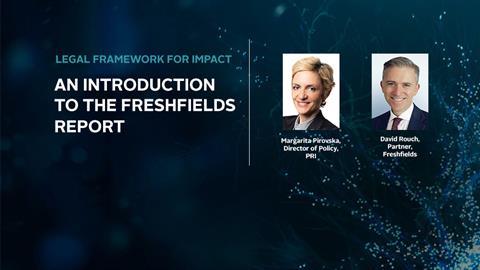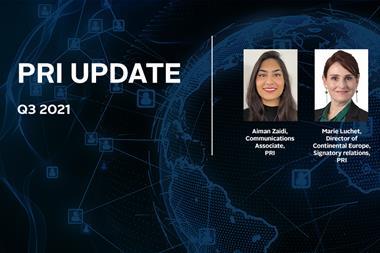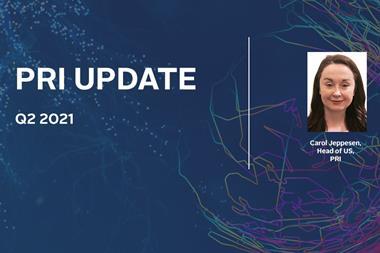Legal Framework for Impact – an introduction to the Freshfields report
With Margarita Pirovska, Director of Policy, PRI and David Rouch, Partner, Freshfields
Note: The Principles for Responsible Investment podcast is designed to be heard. If you are unable to do this, this transcript offers an insight into the episode.
Transcripts are generated using a combination of speech recognition software and human transcribers, and may contain the occasional error. Please check the corresponding audio before quoting in print.
Subscribe to the channel via Apple podcasts, Spotify, or wherever you listen to your podcasts.
Margarita Pirovska, PRI
Welcome to the PRI podcast. My name is Margarita Pirovska and I’m the Director of Policy at the PRI. Today, I’m delighted to be joined by David Rouch, partner at the law firm Freshfields Bruckhaus Deringer. This podcast will present key takeaways and conclusions of the flagship report Legal Framework for Impact, commissioned by the PRI, UNEP FI and Generation Foundation, and authored by Freshfields. This report was commissioned following the conclusion of our previous work on fiduciary duty. Back then, our main conclusion was that investor duties required ESG incorporation, that ESG issues affect investment decisions.
However, there’s no clarity in legal and policy frameworks on whether investors should consider things the other way around, how investments affect ESG issues. All investment decisions have real world outcomes intended or, not positive or negative, but are investors required to understand and manage those outcomes?
Our view is that assessing and accounting for sustainability impact should become a core part of investment activity. That’s why the PRI, UNEP FI and the Generation Foundation commissioned this extensive legal analysis authored by Freshfields to determine the extent to which legal frameworks enable investors to consider impact in their activities across 11 jurisdictions. The result of this extensive research is the flagship report Legal Framework for Impact.
David, this work started more than two years ago. Back then, what was the initial appeal of engaging in such a big project on sustainable finance for a law firm?
David Rouch, Partner, Freshfields
Margarita, first of all, thank you very much for inviting me to join you the day on this really important topic. And I think really what we were interested in is that the subject of the report is strongly aligned with the firm’s view of its own purpose, which includes among other things, creating a better future for our clients, our people, and the communities in which we live and work. Now clearly, the sustainability of people and planet, and because of that, sustainability of business activity is clearly fundamentally important to all of those three things. So, working on such an important piece of analysis provided us with a great way to pursue that part of our purpose. But of course, the other things about this work is that the firm published an earlier report on fiduciary duties, institutional investors, and ESG back in 2005, which has proved enormously influential. And so, people within the firm were understandably very keen to build on that. By looking at a new set of issues.
Margarita Pirovska, PRI
The Legal Framework for Impact focuses on a new question. It is about investment objectives, not simply about investment processes, which have been the focus of our work on fiduciary duty. Fiduciary duty requires a process on incorporating ESG, but what about the objectives that investors pursue? Can investors aim for objectives in addition to financial return? Are there legal impediments to investors adopting impact targets? For example, that investment activities consistent with net zero. So, can you tell us about how you put these notions in a concept to underpin your legal analysis?
David Rouch, Partner, Freshfields
Yeah, that’s right. Margarita. They’re an awful lot of questions out there. And one of the things the report is attempting to do is to provide some kind of a framework to begin answering those questions. But it’s probably helpful to start at the beginning by understanding this concept of investing for impact. Much sustainability related investment activity essentially involves attempting to invoid investor and company specific risks posed by sustainability factors rather than necessarily attempting to tackle the root cause by having a positive impact on the underlying sustainability factor itself. So, what we were asked to look at is whether investors might be required or at least permitted to target bringing about changes in the behaviour of third parties, especially investee companies and policy makers that would help to address some of our sustainability challenges in ways that are assessable. Can investors take steps to make things better?
The assessibility of the intended impact is important for all sorts of reasons, but it’s essentially because if it’s not assessable. No one really knows whether what an investor is doing is really making any difference. Now, there’s a reasonable amount of evidence that individual investors want their money, not just to earn a financial return, but to make a positive difference. But the question is whether that is what the law requires or permits of those managing money on their behalf. So, to test that, we worked with legal teams in the Freshfields offices and our stronger together firms where Freshfields doesn’t have an office to look at the law in, as you said, 11 jurisdictions, including the world main centres of asset management. We also focused in on particular categories of - you know, it’s very common to hear people talking about investors duties as if there was one single duty that applies to all countries and all investor types in those countries.
And that is, that’s just not the case. So, as well as, spreading our analysis across those 11 jurisdictions, we looked at the law as it applies to the three largest types of asset owners by AUM, pension funds, insurance, and mutual funds, and also the rules for their asset managers. It’s also worth saying that analysis of investors duties often focuses on the use of investment powers. But it’s important to recognise that investors use has cover - all of the powers that are available to them. And so, because of that, our analysis also looks at how legal duties might apply to investor stewardship and policy engagement in the context of pursuing sustainability impact goals. Now, as you can imagine, the picture that emerged is very complex indeed, but I’m pleased to say that we were nonetheless able to draw out some common themes.
Margarita Pirovska, PRI
In the report you present a very interesting model to consider different types of investing for sustainability impact. Can you tell us more about this?
David Rouch, Partner, Freshfields
Yes. I think Margarita, you’re referring to the distinction we make between what we call instrumental Investing for Sustainability Impacts or IFSI for short, it’s still a bit of a mouthful. I know, what we’ve called ultimate ends Investing for Sustainability Impact or ultimate ends IFSI. Now this distinction has already attracted quite a lot of interest and, and people are saying that they find it helpful. What it’s intended to do is to focus attention on the goals that investors are pursuing when they are trying to achieve some sort of sustainability impact. So, the first of those instrumental IFSI is where achieving a sustainability impact goal is likely to contribute to the client’s attempts to achieve its financial objective. So, it’s instrumental to achieving financial goals. That’s the first category. The second category ultimate ends IFSI is where an investor is pursuing a sustainability impact goal for some other reason.
In other words, the sustainability goal is more of an end in itself, not so much because of its financial significance. Now it’s really important to emphasise we’re not intending to suggest that the two couldn’t be pursued together or that ultimate IFSI would necessarily be inconsistent with instrumental IFSI. We’re just looking at what motivations might be involved and how they sync up with legal duties because legal duties essentially say that investors are allowed to be governed by some motivations and not by others. And so, it’s really important to distinguish these different motivations, these different goals that investors might have. Now, because, we say quite a lot about instrumental IFSI. Perhaps, it’s worth just picking up on that in a little bit more detail. Perhaps the best example of instrumental IFSI is where deteriorating sustainability. For example, as a result, climate change is likely to damage the performance of whole economies or sectors, threatening an investor’s ability to achieve its financial goals.
In other words, it is a systemic or some people call it systematic sustainability risk for the investor and for society more widely now here an investor might be engaging in instrumental IFSI. If it took steps to bring about changes in economic or policy behaviour that are intended to reduce the risk obviously because challenges of that source are systemic. They need a system-wide response. So, there’s a limit to what an individual investor can actually do. And that’s why we pay a lot of attention in the report to the issue of collective or coordinated action when investors are engaging, in either instrumental IFSI or ultimate ends IFSI because, individual investors are likely to find it very difficult on their own to achieve the sorts of impacts that change whole systems.
Margarita Pirovska, PRI
Over these past two years, we have seen a continuous increase in foundational sustainable finance policies and regulations, which we monitor through our regulation database. But beyond financial policy reforms, the focus on real-world outcomes such as 1.5 degrees has increased tremendously with countries and investors alike committing to net zero. So, understanding how investors may have to consider sustainability targets is key. So, in a nutshell, what did you find?
David Rouch, Partner, Freshfields
Yeah. You’re absolutely right. I mean, the law and regulation in this area has been changing rapidly as we’ve been working on the report. So, we’ve certainly had the sense of having to run to keep up, but also interestingly is worth saying that frequently the legal reforms that are taking place aren’t necessarily focusing on this question of impact. Not at least as far as investor duties are concerned, but to come to the conclusions and putting them in a nutshell, which is always quite challenging for a 550 page report. I think the first thing to say is that it’s clear and not especially surprising that the primary purpose of asset owners’ investment activity that is generally regarded as generating a financial return for their beneficiaries. And that view is shared by legislators, regulators and of course the asset owners themselves. That is then reflected in the terms on which assets owners, appoint investment managers.
So you know, you might think that the story stops there. It’s all about generating financial return, but this is where we get into instrumental IFSI. See, if an asset owner or its manager concludes or on the information that’s available to it all to conclude that one or more sustainability factors is creating a material risk to its ability to achieve its financial investment objectives. It will generally have, and this is consistent across the various jurisdictions that we looked at. It’s generally going to have a legal obligation to consider what, if anything, it can do to mitigate that risk and then having considered it to act accordingly. And possible options in mitigating risk would seem to us and to local council that we worked with to include bringing about specific sustainability impact goals, where achieving those goals can reasonably be expected to help, to influence a relevant sustainability factor and to do so in ways that reduce the asset owners’ investment risk.
So, as I said, that sort of activity is what we’ve called instrumental IFSI. Relevant factors for an investor in deciding whether it should engage in instrumental IFSI include things like the direct and indirect costs and risks of pursuing a given course of action, including as between different general generations of its beneficiaries. And also, the relative likelihood that taking action will help address the relevant sustainability factor. So as to reduce the financial risk posed or to create opportunities. Now an investor might decide to act individually, but both of the factors that I’ve just described, and this comes back to a comment I made earlier, both of those factors we think are likely to weight in favour of a decision to foster or join collective investor action aligned with the relevant goal. So that’s instrumental IFSI turning them to ultimate ends IFSI.
Now there’s obviously going to be a legal duty to engage in ultimate ends IFSI where an investor is managing the assets of an investment arrangement that has been set up with specific sustainability impact objectives. An example would be a mutual fund established with the aim of bringing about a particular source of sustainability impact. But beyond that in most jurisdictions, there are certain other investors who are likely to have some sort of legal discretion to engage in ultimate ends IFSI. Although it is usually in most cases, it is in parallel with the objective of achieving a financial return and frequently subject to it. Examples would include where some asset owners have a discretion to pursue sustainability objectives, provided that certain levels of financial return are achieved, or in other cases, perhaps where beneficiaries have indicated that they want the asset owner to pursue particular sustainability objectives.
Again, that’s generally going to be subject to prioritising the financial return objectives. The other thing to say, I think is that most jurisdictions do have rules prohibiting investors from engaging in certain activities. The most obvious example of this is money laundering legislation and compliance with that sort of legislation could have a positive sustainability outcome. Now, clearly it wouldn’t be usual to think of complying with those sorts of rules as investing for sustainability impact. But that being said, you know, the, the prohibition of support for activities that aren’t aligned with the SDGs and money laundering would be a case in point has the equivalent impact to a collective ultimate ends IFSI decision by investors to achieve a reduction in those activities. So, the effect of it is similar to ultimate ends IFSI.
Margarita Pirovska, PRI
Thank you, David. These are indeed ground-breaking findings, but you have also identified barriers that deter or prevent investors from pursuing sustainability targets. Can you tell us more? What are they?
David Rouch, Partner, Freshfields
Yeah, that’s right. Very broadly and as with everything else in this report, there’s plenty of detail behind this, but we, we identify two categories of barriers. Firstly, limitations that arise from the way that legal rules are currently drafted or understood. I’ve just been talking about the limits on the extent to which investors can engage in ultimate IFSI. So that, that would be an example. And then the other category of barriers, concern the environment within which investors are seeking to discharge their duties. So, for example, the lack of developed market practice for engaging in investing for sustainable impact or that dearth of decision useful information about investees and also possibilities that were raised to us in the course of drafting the report that current portfolio theory or other market features such as the terms governing appointments of investment managers could be causing sustainability factors to be underweighted in the investment process.
Margarita Pirovska, PRI
You have also outlined areas for policy reform in the reports. These are especially important in light of the recent IPCC report and COP 26 policy makers will be looking for ways to facilitate investing to support sustainability outcomes. Can you provide some insights into what those reform areas are?
David Rouch, Partner, Freshfields
Yes. So, it’s important to put this in context. I think we’ve included a number of policy suggestions in the report. What we haven’t covered but what is incredibly important is primary intervention in primary economic activity or fiscal policy, which can then fundamentally affect investment decisions. So, things like carbon pricing, even though policymakers will undoubtedly be focusing on those things. Now I cannot stress enough how important these bigger policy decisions are to investment outcomes. But what we’ve focused on in the report is more specifically this question of investing for impact and how one might address the barriers that we’ve identified to doing so and much like the two sets of barriers we’ve got, the barriers that relate to the way that the legal rules are drafted and operated.
And then, barriers relating to the circumstances in which they are applied, we’ve split the policy options into two categories. So, in the first category options would include changing investors, legal duties, and discretions, and how they are understood. So, as to facilitate investing for sustainability in banks. So, what would that look like? Well, it might involve allowing the pursuit of sustainability goals, as long as financial returns are prioritised. Another possibility might include a presumption in favour of investor collaboration in tackling sustainability challenges, a legal presumption that investors ought to be trying to do that putting the onus on them to decide why they’re not engaging in that sort of collaboration if they’re not going to do so.
In terms of changing the circumstances in which the rules are applied, the policy ideas address three broad areas, and that there is an all-philosophy policy idea so I won’t be able to go into all of them. But the three areas are essentially building the enabling environment for investing for sustainable impact. For example, by ensuring the availability of decision useful corporate sustainability data, which is incredibly important. Second, promoting in-depth research to establish whether indeed there are market features like prevailing investment theory; stock lending to short sellers. Whether there are factors which could be leading investors to underweight sustainability factors in their investment decisions, and to determine what sort of steps can be taken to address that. If so, and then the third area is strengthening market discipline in this era, for example, through a peer, a product labelling and governance rules for sustainability branded products and ensuring that investors sustainability preferences are properly reflected in the investment process.
So that would include the sorts of steps perhaps that policy makers are discussing in the context of and trying to reduce the risk of greed what’s called greenwashing. But they go rather further than that. And, and in particular, again, a lot of the discussion around greenwashing at the moment doesn’t necessarily focus in on this question of impact. It’s got a more diverse scope I would say, at the moment. So, our ideas are much more carefully targeted on this question of impact.
Margarita Pirovska, PRI
Thank you, David. This was a really useful insight into this flagship report. The report can be downloaded at unpri.org/policy. If you’re interested in learning about our future work on embedding sustainability outcomes in financial regulations, you can subscribe to our policy newsletter. You can also reach the policy team at [email protected]. We have a mini-series on COP26 coming up, so stay tuned and thank you for listening.
Interested in the resources discussed in this episode?
View the Legal Framework for Impact report



















